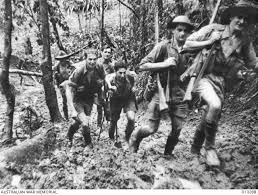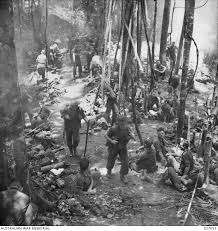Time for some more about the Kokoda Trail in 1942 and the battle
with the Japanese over it.
In July 1942 the Papuan Infantry Battalion was joined by recent
conscripts who arrived with little military training, there average age was
only eighteen and half.
It was these men that were expected to mount the defensive and
at first, they were referred to as “chocos” or chocolate soldiers, a term taken
from George Bernard Shaw’s play Arms and the Man about a man who would not
fight. It was first used in WW1 about soldiers who arrived in Egypt after Gallipoli.
However, after their baptism of fire at Kokoda and Milne Bay these
so called “Chocos” soon proved how bravely they could fight and how well.
The Japanese had first landed in New Guinea in March at Lae and
Salamaua, then in July at Buna and Gona, less than 200 kilometres from Port
Moresby as the crow flies. What stood in their way was the steep range pf the Owen
Stanley Mountains, with the only way over the range being by foot.
As to why they didn’t invade by sea well the battles of the
Coral Sea and Midway put an end to that idea. So, over the mountain they would
go via the Kokoda track.
This as they soon found out was easier said than done.
Major-General Morris was ordered to secure the village of Kokoda,
so he gathered the best of his untrained Australian and Papuan forces for the
task. They left Port Moresby on 7 July and arrived on the15 July.
Even before they found themselves fighting the enemy they had to
fight their way through horrific conditions of the jungle. As well as steepness
of the track, they had to deal with a rainforest dripping with moss and leaches
as well as mosquito infested swamps. Large numbers of men contracted malaria.
Despite being in the tropics, they were continually wet and cold
in the rain and high altitudes. They of course were carrying their equipment
weighing 27 kilos and their heavy boots and khaki summer uniforms were not
suitable for the conditions.
In fact, the khaki made them stand out against the green of the
jungle. At some point camouflage and jungle green uniforms were issued.
That’s enough for this week.







Interesting Jo-Anne. Well done.
ReplyDelete
ReplyDeleteIt's unbelievable what these men had to endure and endure. Wars are terrible.
It's good that you keep the memory of it alive.
Thanks for dropping by history is important to me
DeleteSuch brave and determined young me, Jo-Anne. They put up with all kinds of problems and discomfort, but kept going. Blessings!
ReplyDeleteThat they did, so young and so brave
DeleteThe khaki colors and the jungle--OMG! And carrying all of that in that heat besides the heavy uniforms...had to be awful.
ReplyDeleteThat's for sure must have been such a shock to some of those young men as they really had no idea what they were getting into
DeleteWar is terrible - what they had to go through.
ReplyDeleteSo true
DeleteIt’s remarkable how the soldiers initially underestimated as “chocos” on the Kokoda Trail demonstrated such extraordinary bravery and resilience. Despite their youth and limited training, they played a crucial role in the battle against the Japanese forces. Their performance at Kokoda and Milne Bay not only disproved their critics but also highlighted their remarkable courage and effectiveness under pressure. The term "chocos" might have been a disparaging label, but these soldiers' actions proved their true mettle.
ReplyDeleteI just posted a new blog post, please read: https://www.melodyjacob.com/2024/07/how-to-style-cowboy-hat-denim-on-denim-fashion-tips.html
Well said and oh so true
Delete